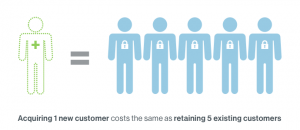
Home / Blog / Using Telemedicine to Improve Patient Loyalty & Satisfaction
Acquiring new patients is the prime focus for any hospital or health system’s marketing department, but how much attention is being paid to patient retention? In many lines of business, the cost of customer acquisition often surmounts the cost of customer retention. Spend less money to keep the patients you’ve already worked so hard to acquire instead of solely focusing a higher amount of spend to continuously attract new patients? Makes sense, right?

So where does a hospital or large health system begin to improve patient loyalty and ensure that existing patients continue to come back for subsequent medical consultations? Today’s patients have choices and if they’re not happy with their first choice, they’ll search until they find one that suits them.
According to AccentureStrategy:
- Consumers are as likely to switch healthcare providers as they are hotels
- 61% would switch providers to get an appointment quickly
- 47% would switch for a better understanding of care costs
- 50% would pay more for weekend or after-hours appointments
So how can telemedicine help with the above? Continue reading to learn how hospitals are already utilizing telemedicine to improve patient loyalty & satisfaction and how yours can, too.
Promotes Price Transparency
The cost of a telemedicine visit is well known to patients prior to initiation of a consultation. A patient knows before they even register how much it will cost them to see a doctor via video or phone call, much different than a typical emergency department trip or even a visit with a primary care physician. When a person is not sure that they need emergency care, but decide to go in for a visit- many are shocked when they walk away with a large bill that averages $1,233. If a patient has the option to be seen online, from home, for $50 or less, the likelihood that the patient will initiate that visit substantially increases and can persuade them from visiting their local retail clinic, urgent care facility, or even utilizing the ED when not necessary. Hospitals and health systems who provide this service to their surrounding area are promoting their brand and linking it to care that is easily accessible and offers transparency around the cost of that care.
Offers Convenient Access to Care
The average wait time to be seen in an ER is 30 minutes while treatment time can take up to 90 minutes, meaning that many people are spending 2 hours or more getting treatment for non-emergency medical conditions in the emergency department. Those who wait to be seen by their primary care physician can be waiting up to 24 days for an appointment, not helpful when you have an unscheduled care need, such as pink eye, and need to be seen sooner rather than later. As noted above, 61% of patients are willing to switch providers in order to be seen quickly, that could mean an existing patient leaves your network in search of someone who provides more convenient care.
What’s more convenient than being able to see an emergency medicine physician while you sit on your couch at home in your pajamas because you’re too sick to venture out in public. Equally as convenient? No longer having to worry about childcare in the event of a late night medical condition. 98% of RelyMD patients said our service and providers helped them save time in their personal life and 90% had no need to seek follow-on care. Additionally, allowing a patient to be seen 24/7 knocks out two birds with one stone by providing easy to access care that’s available both after-hours and on weekends.
And you don’t have to worry about losing a patient to a telemedicine provider. According to the Advisory Board, as many as 20% of virtual care patients could convert to being a full-service patient of a hospital or health system.
Improves Care Coordination
For health systems with a large number of in-network providers, there are many reasons patients break the relationship and seek additional care from a local, competing provider:
- Lack of care continuity between facilities demotes importance of network integrity
- Patients seek easier-to-access outside care during after-hour periods
- Your physicians are referring them out of network
- Medical necessity due to lack of specialists
Telemedicine providers who are able to fully integrate into your network have an easier time of referring patients who came through your telemedicine portal back to a provider in your network for primary care designation in the event they do not already have one established or follow-on care is necessary for a certain condition that cannot be fully treated with telemedicine.
By providing virtual care you can also decrease the chances that they’ll be seen in a retail clinic or urgent care facility where a larger gap can be created in continuity of care. Instead of having a patient with a damaged medical record, you’re instead providing them additional ways to seek care but allowing their medical record to remain intact.
As healthcare transitions to a more service-oriented field, very different than how it has been viewed in the past, improving your patients’ experience will greatly improve patient loyalty they have towards your organization. Adapting the way your hospital or health system provides care will allow you to consistently prevent your existing patients from seeking care from alternative competing facilities- telemedicine is just one way to implement that change.
July 20, 2017
If you’re ready to learn how RelyMD can help your hospital or health system improve patient loyalty, fill out the form below.
[pardot-form width=”400″ height=”300″ id=”807″ title=”Web Form – Blog – Learn More”]
